The Way It Is/ Indy car racing's Cosworth revolutionby Gordon Kirby |
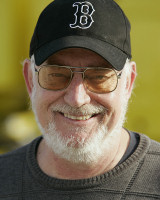 In the winter of 1974-'75 Parnelli Jones decided to tackle building a new turbocharged version of Cosworth's DFV Formula 1 V-8 to compete in Indy car racing. To make this project happen Parnelli hired John Barnard to develop a car based on the Parnelli F1 car while VPJ's engine shop went to work on the engine, called the DFX. At the time, Barnard was a junior engineer at McLaren, drawing suspension and wing updates for the M16C Indy car. Barnard started his career a few years earlier at Lola Cars before moving to McLaren where he worked beside F1 and Indy car designer Gordon Coppuck.
In the winter of 1974-'75 Parnelli Jones decided to tackle building a new turbocharged version of Cosworth's DFV Formula 1 V-8 to compete in Indy car racing. To make this project happen Parnelli hired John Barnard to develop a car based on the Parnelli F1 car while VPJ's engine shop went to work on the engine, called the DFX. At the time, Barnard was a junior engineer at McLaren, drawing suspension and wing updates for the M16C Indy car. Barnard started his career a few years earlier at Lola Cars before moving to McLaren where he worked beside F1 and Indy car designer Gordon Coppuck.
One day Barnard got a phone call from former Lola man Jim Chapman who was then team manager for VPJ's Formula 5000 and Indy car teams. Ex-Lotus designer Maurice Philippe had left the team after producing some middlingly successful Indy and F1 cars for VPJ, and Chapman proposed to Miletich and Jones that Barnard should replace Philippe. Barnard redesigned the Parnelli F1 car producing a svelte new Indy car called the VPJ6B that introduced the turbo Cosworth DFX to Indy car racing. Over the next dozen years the DFX would dominate Indy car racing winning 151 races, including ten consecutive Indy 500s between 1978-'87. After three years in California with VPJ, Barnard moved on to design Jim Hall's equally revolutionary Chaparral 2K Indy car before joining McLaren in 1981 where he designed the first carbon fibre McLaren MP4/1 Formula 1 car. Barnard worked for McLaren for six years then moved to Ferrari where he worked in 1989 and '90 and again from 1993-'97 carving a niche as one of the greatest racing car designers of his era. 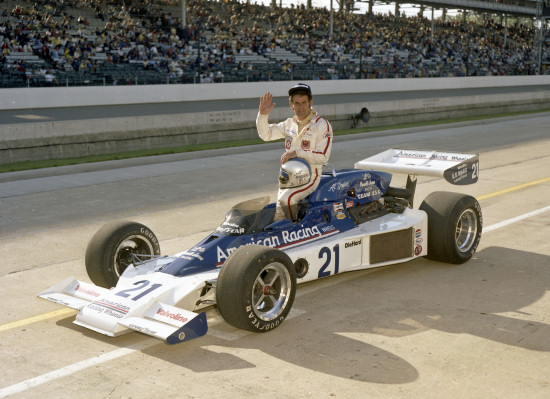 © IMS ~ Al Unser and the Parnell VPJ6B "The engine was nice and compact and the car had basically the same outside configuration as the Formula 1 car," Parnelli says. "It made a great combination. It was a cool car, a great car. It was sort of a take-off on our Formula 1 car and it was the fastest flat-bottom car around until the ground effects cars came in." Adds Barnard: "It was a completely new chassis. We put coil springs on the rear, but I kept the torsion bars on the front. It was very different than the current cars. We had the Eagle-Offies sitting in the workshop and it was like looking at a truck against a Formula Ford. You look at the McLaren M16s and they were also big buggers compared to the Parnelli. It was a real step." Barnard found himself equally involved in VPJ's Cosworth DFX development program. "Apart from the car there was lots to do on the engine--inlet manifolds and all sorts of things," Barnard recalls. "I was drawing con rods and pistons, an oil pump system, a fuel injection system and God knows what else. It was fantastic for me because I had never really got into engines much but we had our engine shop with Larry Slutter and Chickie Hirashima and all those guys so we could do all this stuff to every part of the car and engine. It was fantastic! I couldn't believe it. It was just like having a toy shop." At Cosworth in the UK however, there was little or no support from Keith Duckworth for turbocharging the DFV. "I remember Vel Melitich telling me that Cosworth were sitting back there in the UK telling him that he was a bit of a twit trying to get all this horsepower out of an engine that was designed to make 500 bhp and there we were getting over 800," Barnard recounts. 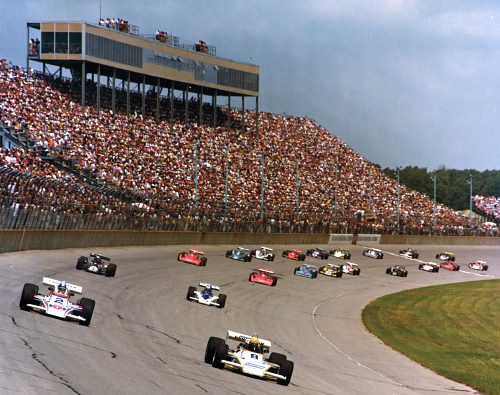 © Penske Restoration ~ Cosworths lead the field in 1977 Duckworth famously didn't believe in turbos. "I remember him giving me a lecture about turbos and another one about 4WD," Barnard adds. "He gave me a long lecture one day about why 4WD wouldn't work." Unser and Andretti ran a few practice laps at Indianapolis that year in an early version of the VPJ6 and the first complete 6B made its debut in Unser's hands in 1975's season-closing race at Phoenix, finishing fifth. Unser scored the Parnelli-Cosworth's first win in the Pocono 500 in June of 1976, then won again at Milwaukee in August and Phoenix at the end of the season. "We proved that the engine worked and we brought Duckworth over to Pocono because we wanted to get a distributorship for the Cosworth Indy program," Parnelli recalls. "So Duckworth came over and damned if he didn't turn around and steal Larry Slutter and Chickie from us." Barnard took a dim view of Duckworth's maneuver. "As soon as we won Pocono, Cosworth shut up and saw the light," Barnard comments. "It wasn't long afterwards that they hired Larry Slutter and set their own engine shop up right there in Torrance, which I thought was pretty mean. "I was told by somebody at Cosworth many years later that the turbo Indy engine program--the DFX as they called it--was their most profitable program of all. So I wasn't impressed with Cosworth in the way they did that. Vel and Parnelli were the ones putting their hands in their pockets to develop this car and engine and I don't think they ever got the proper credit. Cosworth steamrollered in and ran away with the profit." 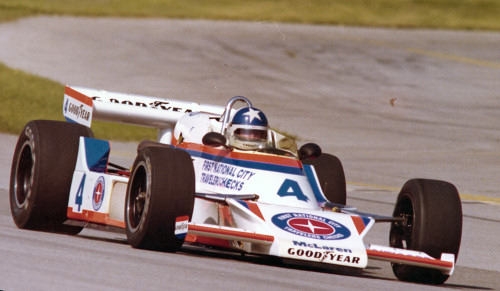 © Racemaker/Dennis Torres ~ Rutherford's McLaren M24 in 1977 "We were in a catch-22 because you had to satisfy your sponsors and we needed to order parts from Duckworth," Parnelli remarks. "We could have sued him and not let him do what he did to us, but we decided not to do that. We decided to try to work with him." For the 1977 season both McLaren and Penske started building their own Cosworth DFXs. McLaren and Penske also built new F1-based cars with Cosworth engines and Tom Sneva won the USAC Championship aboard Penske's Cosworth-powered McLaren M24s and a Penske PC5, which was Penske's first Indy car. Johnny Rutherford won four races in 1977 driving McLaren's factory M24-Cosworth while Al Unser and new teammate Danny Ongais each won a single race for VPJ with Unser taking the California 500. Ongais's car was sponsored by Ted Field under Field's Interscope banner. Field and Interscope became VPJ's primary sponsor in 1977 and '78 after Firestone announced they were pulling out of racing. Firestone had been Parnelli's major sponsor since his driving days and the tire company's withdrawal resulted in Unser leaving VPJ at the end of 1977. In 1977 Cosworth-powered cars won eight of fourteen USAC Championship races and the following year Cosworth engines won all but four races, including the Indianapolis 500. So it took only three years for the Cosworth to sweep aside the venerable Offy and Foyt's Ford-based engines. Aside from Foyt's win with a Coyote-Foyt/Ford at Texas in 1979 and Mike Mosley's famous come-from-behind win at Milwaukee in 1981 with Dan Gurney's favorite AAR Eagle-Chevy, every USAC and CART race through 1986 would won by a Cosworth DFX. USAC's 1977 and '78 championships were won by Tom Sneva driving Cosworth-powered McLarens and Penskes for Penske Racing. Sneva won two races in 1977 and was on the pole at Indianapolis where he finished second to Foyt. The following year Sneva was again on the pole at Indianapolis, becoming the first man to run four qualifying laps over 200 mph (his average was 202.156 mph). But Sneva was beaten to the checkered flag in the 500 by Al Unser and failed to win a race in 1978. Sneva easily beat Unser to the championship by finishing fifteen of sixteen races, but Penske was unimpressed and fired him at the end of the season. Al Unser left VPJ to join Jim Hall's new Indy team in 1978 and Unser won all three USAC 500-mile races that year in Hall's Lola-Cosworth, thus scoring Cosworth's first Indy 500 win. Hall's team had a huge impact on Can-Am and long distance sports car racing in the sixties and the Texan partnered with Carl Haas in the mid-seventies to win three straight Formula 5000 championships and two of Haas's four consecutive 'new era' Can-Am titles. 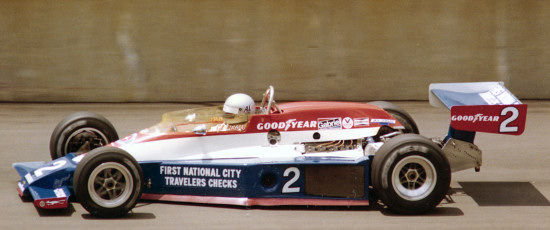 © Racemaker/Torres ~ Al Unser's Lola T500 in 1978 "How we did that I'll never know," Al shakes his head. "That car didn't handle good at all. But I still won the three 500s and I can't say why. Yes, I had a good team and yes, everything went right. But that car, other than the three 500s, was a shitbox. The team made it finish. We really figured we were a third or fourth-placed car but they just backed-up to me and I went by them. From halfway on we just dominated the race and we were all surprised. At the end it was my day. It was one of those good times." Meanwhile, a revised Parnellli, called the VPJ6C with improved aerodynamics and transverse gearbox was introduced in 1977. Danny Ongais continued in a lone Interscope Parnelli in 1978 and won a season high five races. He also took eight poles, but that was the end of the road for VPJ. The F1 team had been closed early in 1976 and now the Indy car team was also shuttered. "When Firestone got out of racing that certainly left us hurting financially," Parnelli says. "We had to let Barnard go, and of course Al too, because we had no heavy-duty sponsor. We had a good operation. I think if Firestone hadn't decided to get out of racing we would have continued on. "We had Ted Field putting up some money for Danny Ongais and that was about it. We took the car out to Ontario after Al had left and Foyt jumped in it and set quick time with it and he fell in love with the car. So we furnished him with a couple of cars." Foyt raced his own Parnelli 6C in 1979 and continued to race the car into 1981. Foyt won four USAC races aboard his 6C in 1979 and scored the last of his 67 wins with the car. Ongais also continued to race his Interscope Parnellis in 1979 and '80 as the car continued to be competitive against the early ground-effect Indy cars from Penske and Chaparral. Amid all the many changes and technical revolutions that occurred through the seventies the USAC Championship fell into increasing turmoil. Beyond the Indy 500 the series was commercially very unhealthy. 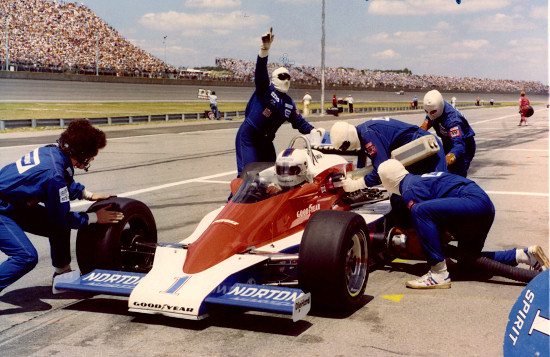 © Racemaker/Torres ~ Sneva's Penske PC6 in 1978 "The economics were impossible," Parnelli says. "If we had $500,000 in sponsorship we were spending $1 million and if we had $1 million in sponsorship we were spending $2 million. We could never get ahead. Every year was costing us more money." In contrast, NASCAR and many other major sports leagues from football to golf and tennis were beginning to seriously grow their television coverage and rights fees as well as sponsorships and crowds. The Indy car team owners complained for years about increasing costs versus poor return in prize money and sponsorship. They were particularly vocal about the engine rules. Run at big boost the turbo Offies were notoriously unreliable and engine failures tended to be a feature of many USAC races through the mid-seventies. Indeed, the problems with the aging Offy was one of the reasons Parnelli Jones decided to develop the Cosworth engine. Meanwhile Dan Gurney sat down and wrote his famous 'White Paper'. Gurney wrote that Indy car racing had huge potential if only there was a proper vision, technically and commercially, and the series was run by a small, focused and totally professional management team. In 1978 the team owners--Penske, Teddy Mayer and Tyler Alexander of McLaren, Pat Patrick, Gurney, Jim Hall, A.J. Foyt, Bob Fletcher and Jerry O'Connell--formed a union designed to act as a collective pressure group to get things done, but their presence was not appreciated by USAC. This was a seminal time for the sport because Tony Hulman passed away in 1977 after 32 years at the helm of the Indianapolis Motor Speedway. Then in the spring of 1978 a 'plane crash took the lives of some key USAC officials, including respected veteran technical director Frankie DelRoy, sprint car director Don Peabody and public relations director Ray Marquette. The loss of these people didn't help the poor communications between the sanctioning body and the team owners and when USAC rejected the team owners' entreaties towards the end of 1978 the owners made the decision to form their own sanctioning body called Championship Auto Racing Teams, or CART. In the coming weeks, after covering this year's 100th running of the Indy 500, I'll review CART's breakaway from USAC and the start of a new era in American motor racing. |
|
Auto Racing ~ Gordon Kirby
Copyright ~ All Rights Reserved |
